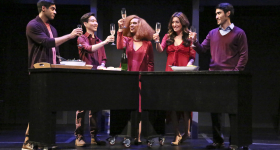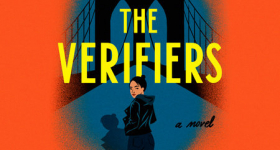Photographer P. G. Rafanan
Artist Michael Arcega builds a seaworthy galleon and a coat of armor—all out of manila folder; sails it through Tomales Bay, and christens the project “El Conquistadork.” From office supplies in “El Conquistadork” to canned meat product in “SPAM/MAPS,” Arcega coaxes meaning from the mundane by manipulating materials and language.
Hit us with the basics.
Michael Arcega: I was born in Manila, the year after Benigno Aquino got shot. That was like, fifth grade? A year later we moved to L.A. and I lived there until I moved to the Bay Area to go to Art Institute … Other people would say my work is humorous, well-crafted, political, identity based. They would probably say that it’s smart, probably smart-ass (laughs). But I try to stay away form being locked into “identity art.” It has so many connotations, I’d like to see myself and other people working in topical or political issues go beyond that. I want to be more open so that other people can relate to it. That’s the attempt at least. I hope that my work is humorous but with a bite. In the end or the beginning or wherever, but with a bite somewhere.
How do you balance playfulness with the themes of conquest, colonialism, war and violence? How do you reconcile humor and history?
It’s a tricky balance. I take mental notes on how comedians communicate. They deliver the message with a spoonful of sugar. I think The Simpsons do it best. But I’m also afraid of being didactic. I’m not here to lecture. I’d rather begin a conversation rather than end it. Like “El Conquistadork Project.” If it weren’t called “Conquistadork” it would be this macho thing. But by adding this one little “k,” it creates a change in perception and it becomes self-deprecating.
Tell us more about “El Conquistadork.”
It’s a 13-foot long 16th to 17th century Spanish galleon made out of manila folders and manila rope. I sailed it in Tomales Bay in February 2004. I wanted to replicate the voyage of the galleons that started in Acapulco. They would load the galleon with gold and silver from South America and take that to the Phillipines and trade for spices, laquerware, porcelain and the occasional slave. Because of trade winds, they would end up in California and restock near Drake’s Bay. Drake used to hunt Manila galleons. From there they would head down to Acapulco and disperse it to the Viceroy of Mexico or whoever. They actually had to stop the trade because they were afraid that Mexico was getting too powerful. It was just so lucrative. So that’s what I was trying to do—but on a really small scale.
But it actually sailed!
Yeah, it was coated with epoxy and fully functional. It had rudder control and nylon shower curtain sails. I had friends in wetsuits in the water with me. I found out a few months ago that Tomales Bay is actually one of the breeding grounds for great white sharks. I still haven’t told them.
Has your work ever been responsible for injury?
I made a world map out of Spam (“SPAM/MAPS: World”) for a show. The fat from the Spam was dripping onto the gallery floor. The curator’s Chihuahua started licking it up. It got sick and threw up.
You play a lot with language in your work especially when it comes to titling your pieces.
Growing up bilingual, it was one of my toys. My friend Lester and I used to fuck around with my parents and jumble their words (tries to come up with example) but yeah—just jumble words like an old man. Being bilingual allows you to collide and confuse things. An accent dissolves language. It’s a form of ownership. We pretty much learned in English in the Philippines and it became a form of getting back at that dominant language … There’s tons of Filipino jokes like “use devastation in a sentence” (mocks Filipino accent) ‘I wait for the bus at the bus station.’ There’s so many. I could keep going … but realizing that you could use language and art was a major revelation to me. Like Bruce Nauman and Gary Hill and Duchamp. Duchamp put a moustache on that painting. Agh, the painting—the famous one!
The Mona Lisa?
Yes, yes—and titled it LHOOQ. When you spell it out loud (in French) it translates to something like ‘what a hot ass’. So it has a long history, and recognizing that I had been doing the same thing and that it was part of the contemporary art language was really great. So I went with it and I’ve been doing it since.
The titles and the materials in your pieces always reference each other. How do you choose your materials?
It has to be the actual material because of what it means. Like I can’t use gold spray paint instead of gold leaf. And if I can’t afford gold leaf, that might change the project. It depends a lot on what’s available to me, but it has to be the real thing. With Spam, I was just thinking about why Filipinos eat so much Spam. And manila folders, well they’re manila folders.
Why are they called manila folders?
I think it has something to do with the pulp being originally produced in the Philippines.
You’ve made maps out of meat and a ship out of office supplies, and now you’re considering 24k gold leaf. If you had all the time and money in the world, what would you create?
It’s hard to say because my materials are really limited by what I have available … But if I could do anything, you know, I would really like to sail “El Conquistadork” in Acapulco and Manila. I’d like to complete the voyage.
In 2006 Arcega’s “El Conquistadork” will dock at the Contemporary Museum in Honolulu as part of Alimachuan: The Artist as American-Filipino. Arcega’s work will also be featured in a group exhibition of Asian American Art at the Asia Society in New York City. The exhibition will travel to The Blaffer Museum at the University of Houston; The Berkeley Art Museum, Berkeley, CA; and the Japanese American National Museum, Los Angeles.









Comments